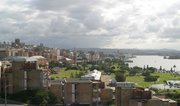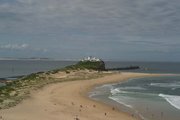Newcastle Australia Information
Home > Australian Information > Australian Localities > Newcastle
Newcastle, New South Wales
From Wikipedia, the free encyclopaedia
Newcastle, New South Wales, Australia, is an industrial port city 160km north of Sydney, on the mouth of the Hunter River.
Population
The metropolitan area of Newcastle spreads over several Local Government Areas. The estimated population of the City of Newcastle at June 2003 was 144,375 (Australian Bureau of Statistics), but its neighbour, the City of Lake Macquarie, was actually larger, with an estimated 189,150 residents as of June 2003 (ABS). The combined population of the Newcastle area at the 2001 census was 470,610, making it the sixth largest city in Australia.
Geography
Newcastle is located on the southern bank of the Hunter River at its mouth. The northern side is dominated by sand dunes, swamps and multiple river channels. Because of this, urban development is mainly restricted to the hilly southern bank. The small village of Stockton sits opposite Newcastle at the river mouth and is linked by ferry. Much of the city is undercut by the coal measures of the Sydney sedimentary basin, and what were once numerous coal-mining villages located in the hills and valleys around the port have merged into a single urban area extending southwards to Lake Macquarie.
History
The first European to explore the area was Lt. John Shortland in 1797, and in 1798, coal mined from the area was the New South Wales colony's first export. An attempt to establish a permanent settlement in the area (then called Coal River) failed but in 1804 the current city (briefly called King's Town) was established. Initially it was a penal settlement, with agriculture the only industry.
Coal mining began in earnest in the 1830s. In the 1890s a zinc smelter was built by Cockle Creek. In 1915 the BHP steelworks opened beginning a period of some 80 years dominated by the steel works and heavy industry. With the closure of the steel works in 2000 and the expected closure of the Sulphide Corporation works by 2006 the era of heavy industry is passing and the city's population is growing, attracted by its coastal lifestyle, excellent education and health services and improving employment opportunities in the tertiary sector. Newcastle's clichéd image as a grimy steel town is fading.
On December 28, 1989, Newcastle experienced an earthquake measuring 5.5 on the Richter scale which killed 13 people. The following economic recession of the early 1990s meant that the city took several years to recover. Coincidentally, a small island now known as Nobby's Head was joined to the mainland, a distance of about 50 metres, with rubble from the 1906 San Francisco earthquake. Newcastle is also often recognised by San Franciscans as having a similar culture to that city, albeit on a smaller scale.
Newcastle Today
The Port of Newcastle remains the economic and trade centre for the resource rich Hunter Valley and for much of the north and northwest of New South Wales. Newcastle is the world's busiest coal export port and Australia's oldest and second largest tonnage throughput port, with over 3,000 shipping movements handling cargo in excess of 90 million tonnes per annum (mtpa), of which coal exports represent more than 90%. Newcastle also has a substantial ship building industry.
The old Central Business District, located at Newcastle's eastern end, still has a considerable number of historic buildings, dominated by the Christ Church Cathedral. Other noteworthy buildings include Fort Scratchley, the Ocean Baths, the old Customs House, the 1920s City Hall, and the 1930s art deco University House (formerly NESCA House). After the 1989 earthquake much of the new commercial developments have concentrated around the suburbs of Hamilton and Charlestown. The city is serviced by two railway lines, including an hourly train service to Sydney, as well as the nearby Williamtown airport (also a major Air Force base).
The University of Newcastle (formerly part of the University of New South Wales) obtained its autonomy in 1965 and now with a student population of just over 20,000 offers over 150 undergraduate and graduate courses, delivered via five Faculties - Business and Law; Education and Arts; Engineering and Built Environment; Health; and Science and Information Technology.
Newcastle has an active youth music culture. Bands and groups produce in both guitar based and computer based music for a pub based concert scene. Silverchair, the highly successful Australian band, hailed from Newcastle.
Unlike those of its British namesake, who call themselves "Geordies", residents of Newcastle, NSW refer to themselves as "Novocastrians".
Media
Newcastle is served by a daily newspaper (Newcastle Herald) and several weeklies (including Newcastle Star). In addition, several of the outlying communities, including Cessnock and Maitland have newspapers of their own.
The city is also served by several local radio stations, including those owned by the ABC and SBS.
AM stations
2HD (commercial)
2NC (ABC Local Radio)
FM stations
New FM (commercial)
2NUR (community)
KOFM (commercial)
NXFM (commercial)
Nationally owned services
ABC News Radio
Triple J (youth station)
ABC Classic FM (classical music)
SBS Radio (foreign language service)
Other stations
2KY Racing Radio (as part of state-wide network)
Newcastle is also served by 5 television stations, three commercial and two national services, and by Foxtel pay television.
NBN Television (Nine affiliate, incumbent station, established 1962)
Southern Cross Ten (Ten affiliate, established as a result of aggregation on December 31, 1991)
Prime Television (Seven affiliate, established as a result of aggregation on December 31, 1991)
ABC Television (owned by the government, established in the 1960's)
SBS Television (owned by the government, introduced in the 1980's)
Sport
Newcastle has a thriving sports culture centred on the Newcastle Knights Rugby League team. Other major spectator and participant sports include Netball, Basketball, Soccer, AFL, Rugby Union, Hockey and Surfing.
Teams participating in national sports leagues are:
Newcastle Knights (National Rugby League)
Hunter Pirates (National Basketball League)
Hunter Jaegars (Commonwealth Bank Trophy (Netball))
Newcastle United Jets (Hyundai A-League (Football))
Newcastle hosts the annual surfing contest 'Surfest' on the world professional surfing tour. Four time world champion surfer Mark Richards grew up surfing at Newcastle's Merewether Beach.
Famous Novocastrians
Steve Abbott (aka The Sandman), comedian
Su Cruickshank, singer
Mikey Robbins, comedian
John Doyle (aka Roy Slaven), comedian
Rock band Silverchair
Dave Sands, boxer
Yahoo Serious (Greg Pead)
John Paul Young, singer
Temperature and Weather
Average Annual Temperature: 12.4 - 23.0ºC (54.3 - 73.4ºF)
Average January Temperature: 18.0 - 27.8ºC (64.4 - 82.0ºF)
Average July Temperature: 6.4 - 16.9ºC (43.5 - 62.4ºF)
Days over 30ºC (86ºF): 37.0
Days over 35ºC (95ºF): 8.9
Days under 2ºC (35.6ºF): 4.8
Days under 0ºC (32ºF): 0.7
Annual Rainfall: 1120.4mm (44.11 inches)
Average annual wind speed: 13.3 - 20.0 km/h (8.3 - 12.4 mp/h)




